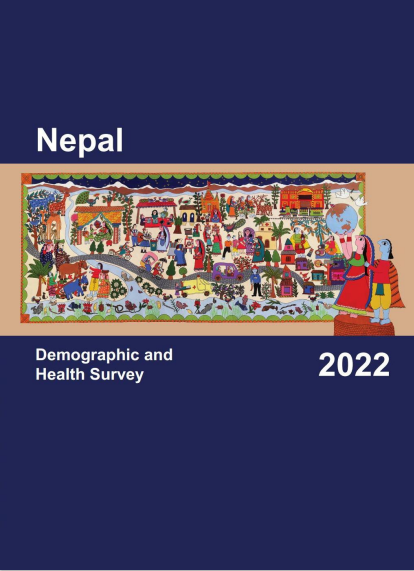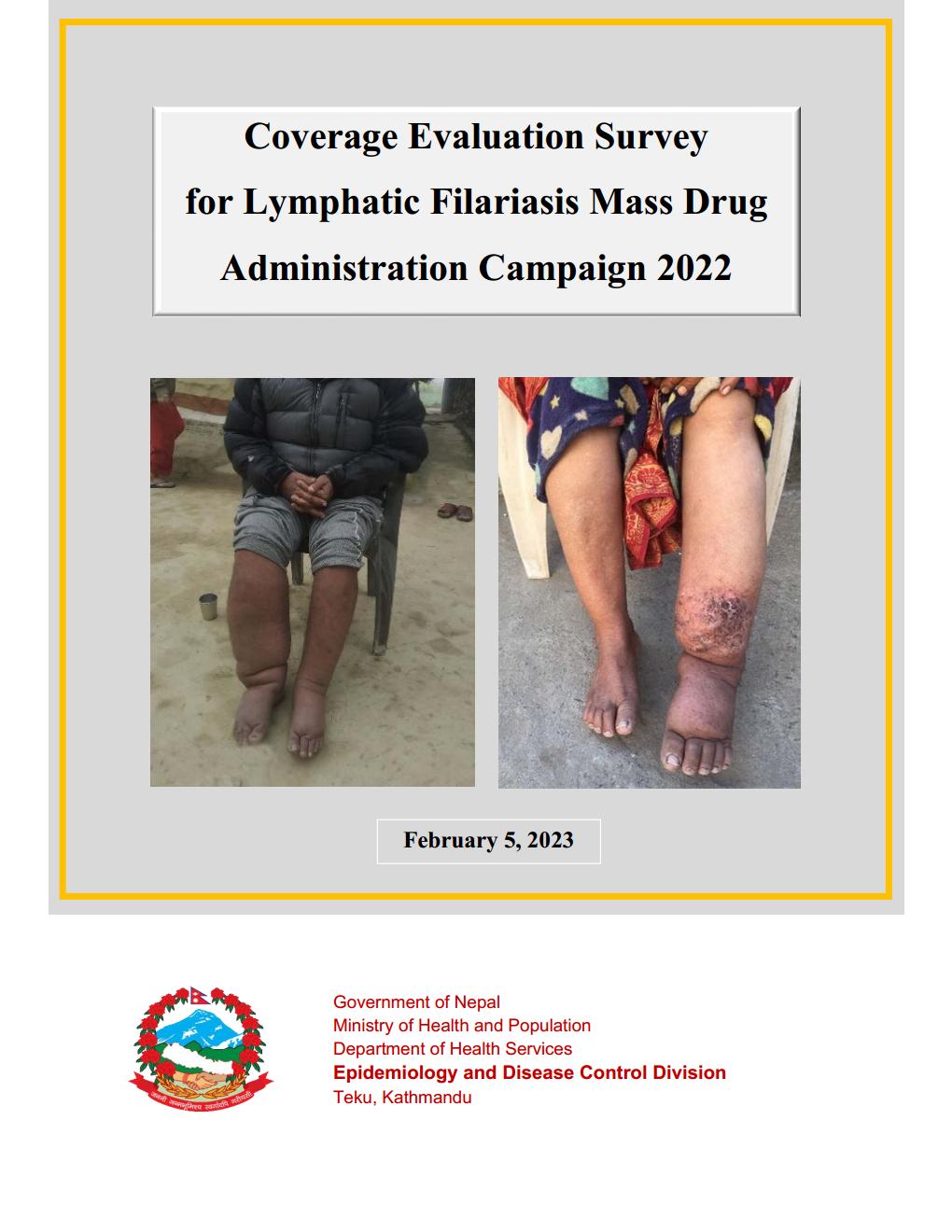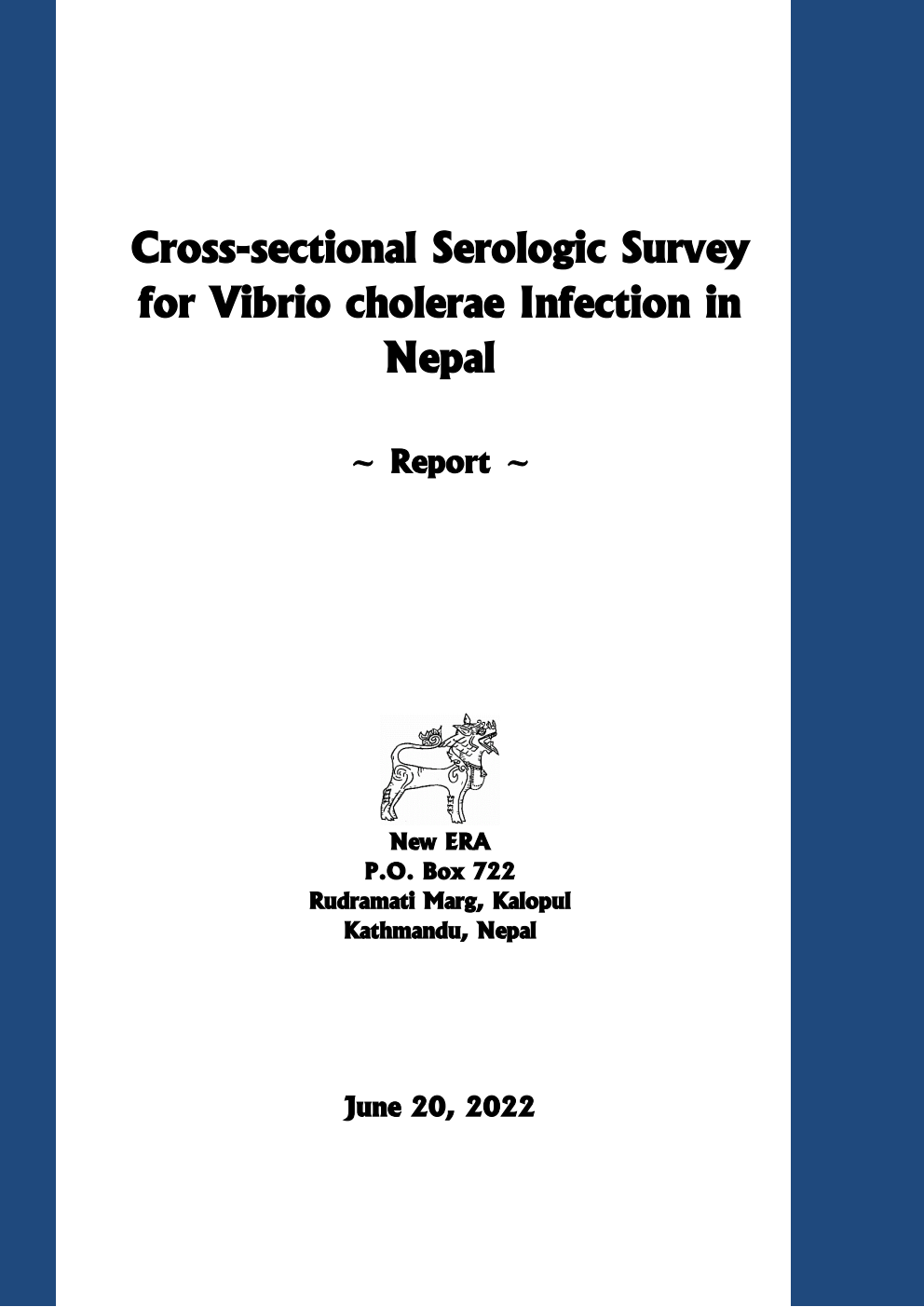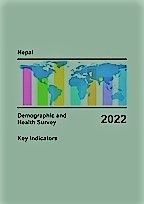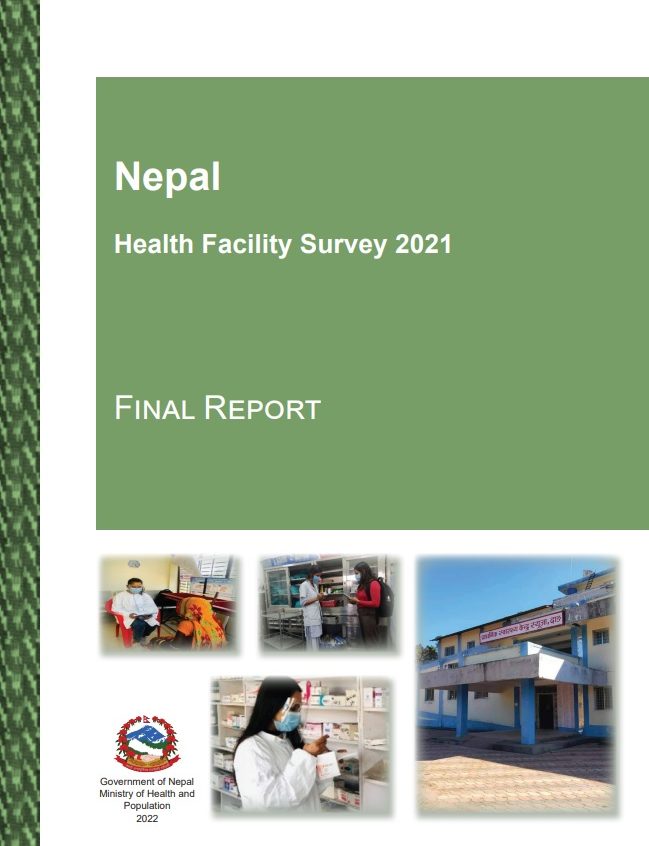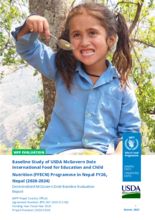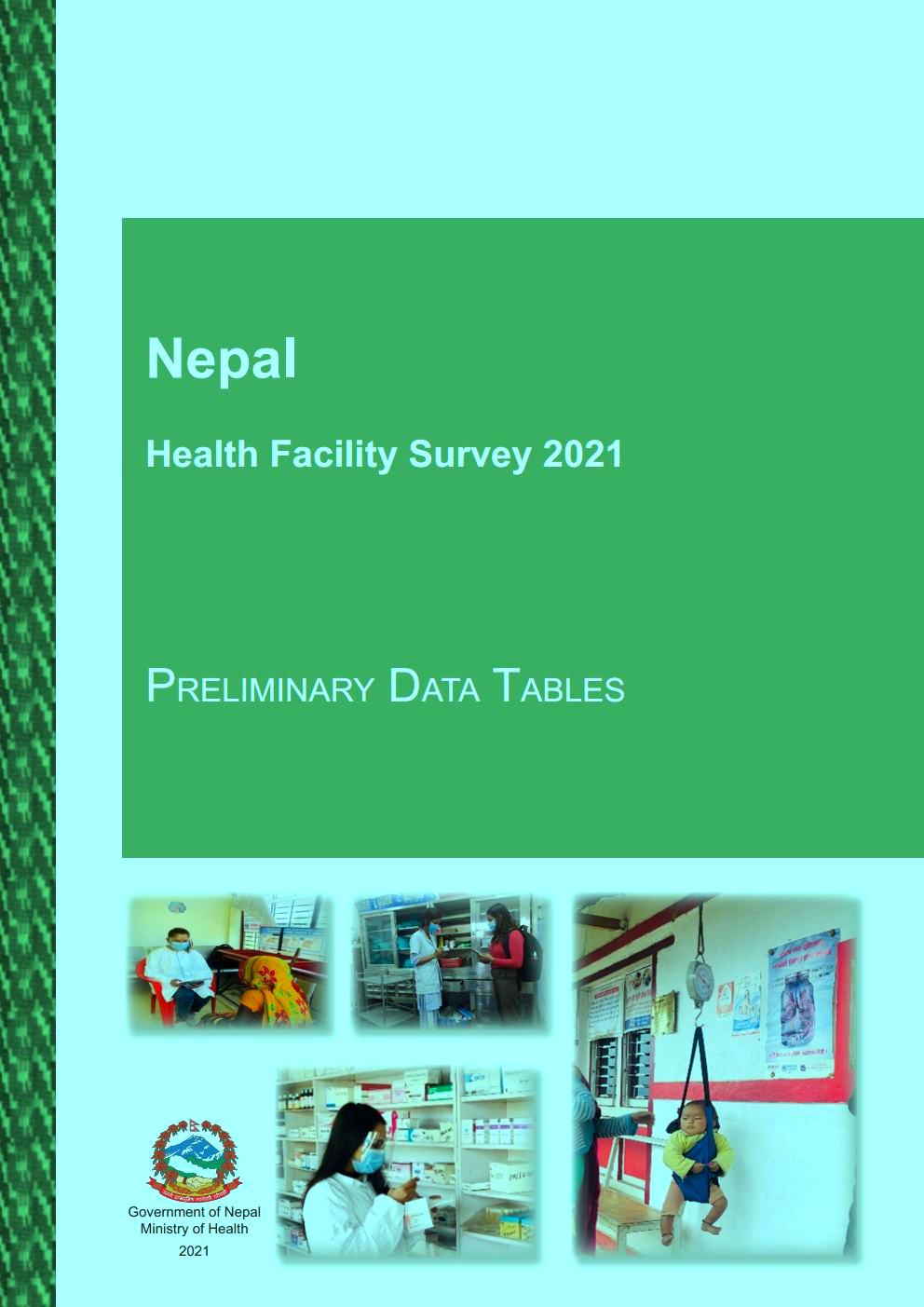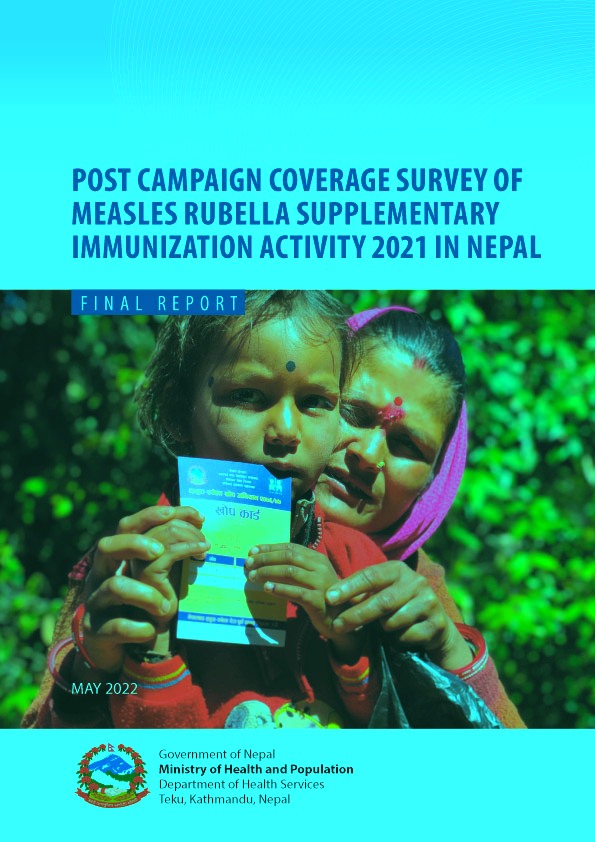Report Type: Health
Coverage Evaluation Survey for Lymphatic Filariasis Mass Drug Administration Campaign, 2022
In 2017, WHO recommended an alternate strategy to accelerate Lymphatic Filariasis (LF) elimination using a triple drug regimen, Ivermectin, diethylcarbamazine (DEC) and Albendazole (IDA) for mass drug administration. Following this recommendation, triple drug regimen for endemic districts was adopted in 2019. EDCD introduced triple drug regimen in five districts (Morang, Kapilvastu, Dang, Banke, Kailali) from 2022. This survey estimated mass drug administration coverage, validate reported coverage rates and identify reasons for non-compliance. The survey also detected problems with the supply chain and distribution systems (programs reach), as well as measured coverage in specific population.
Suaahara Annual Monitoring Survey- Year 6
With the aim to reduce the prevalence of stunting, wasting and underweight among children under five years of age and to reduce the prevalence of anemia among women of reproductive age 15-49 years and children 6-59 months of age, USAID- funded multisectoral nutrition program that aligned with Nepal’s Multisector Nutrition Program was implemented in all communities of 42 of Nepal’s 77 districts from April 2016 to March 2021. To assess the progress of the Suaahara II project, annual monitoring surveys were carried out every year.
SII Annual Monitoring Survey was a quantitative survey design. The first, second and third SII Annual Monitoring Surveys were also conducted by New ERA in the year 2017, 2018 and 2019. SII Annual Monitoring Survey year six was the last annual monitoring survey of SII and it interviewed mothers of index child (0-59 months old) and followed up adolescents from 2017 survey.
Suaahara Endline Evaluation Survey 2022
Suaahara Endline Evaluation Survey was a quantitative study. Using a cross-sectional design, this survey measured the effects of program interventions on pre-selected regions or individuals with non-random allocation to intervention packages and control groups. A multi-stage cluster sampling approach was employed in this survey to head of household, mothers of children under 5, women aged 15-49, FCHV and health facility from four intervention districts (Darchula, Syangja, Rupandehi and Sindhupalchowk) as well as four control districts (Jumla, Tahahu, Chitwan and Ramechhap).
This endline evaluation survey assessed whether Suaahara reduced maternal and child under-nutrition and improved household behaviors related to health, nutrition and child under WASH, as well as whether Suaahara interventions improved the health services.
Enhancing Cholera Control in Nepal (ECHO-N)
The survey estimated the sero-incidence of recent Vibrio cholera O1 infection in Nepal using cross-sectional serologic markers. The study assessed correlation between self-reported diarrheal symptoms and Vibrio cholera immunological markers in individuals; conducted geospatial analysis to identify priority intervention areas (i.e., cholera hotspots); assessed correlation between acute watery diarrhea surveillance data in the national reporting system and estimated recent incidence of Vibrio cholera infection in geographically defined areas. New ERA conducted national representative cross-sectional survey to collect risk factors associated with diarrheal diseases, and collected serum sample for laboratory testing.
Nepal Demographic and Health Survey 2022 – Key Indicators
This survey is the tenth in a series of national-level population and health surveys and the sixth comprehensive survey conducted as part of the Global Demographic and Health Surveys (GDHS) program. The objective of this survey is to collect data on fertility levels; contraceptive use; maternal and child health; childhood mortality; childhood immunization; breastfeeding and young child feeding practices; women’s dietary diversity; violence against women; nutritional status of women and children; awareness regarding HIV/AIDS and sexually-transmitted infections; tobacco use; disability; mental health; accident and injury; fistula, and other indicators relevant for the Sustainable Development Goals.
Nepal Health Facility Survey 2021
This is the second comprehensive sample survey of formal sector health facilities in Nepal. The study was designed to provide information on the high quality data on essential health care service. The examined the preparedness of facilities to provide quality health services in child health, family planning, maternal and newborn care, HIV, sexually transmitted infections, non-communicable diseases, and tuberculosis. The study also assesses client perception on services, financial and personnel management, feedback and accountability systems.
Baseline Survey of USDA McGovern-Dole International Food or Education and Child Nutrition Programme FY, Nepal (2020-2024)
The objective of this survey was to establish baseline indicator for (PMP) Performance Monitoring Plan. The study provided a situational analysis before the project begins, and the context necessary for the midterm and end-line evaluations to assess the project’s coherence, relevance, effectiveness, efficiency, sustainability, and impact. The study also explored the factors contributing to the literacy achievement of school-age children besides school meals and standard academic curriculum.
Nepal Health Facility Survey 2021 – Preliminary Data Tables
This is the second comprehensive sample survey of formal sector health facilities designed to provide information on the availability of essential health services, readiness of health facilities to provide those services and quality of client services. The study assesses general and specific readiness of health facility to provide clients; quality of services; client perception on services; financial and personnel management; feedback and accountability systems. The study also focused on building the survey capacity of Nepalese professionals in the government and private sector of Nepal.
Post Campaign Coverage Survey of Measles Rubella Supplementary Immunization Activity 2021 in Nepal – Final Report
The survey covered entire country in two phases, reaching children 9 to 59 months with measles rubella vaccine. The objective of this survey was to estimate the proportion of children who were 9-59 months old at the time of the SIA who were vaccinated with Measles Rubella (MR) vaccine in the SIA conducted in 2020. The study assessed proportion of children reached in the campaign and those were yet to be reached by routine immunization program.



